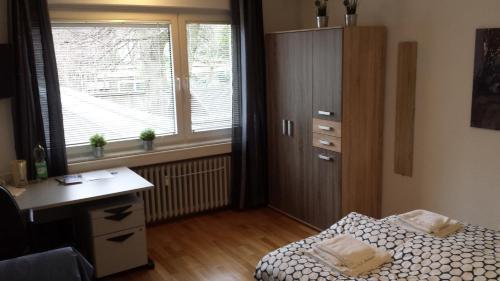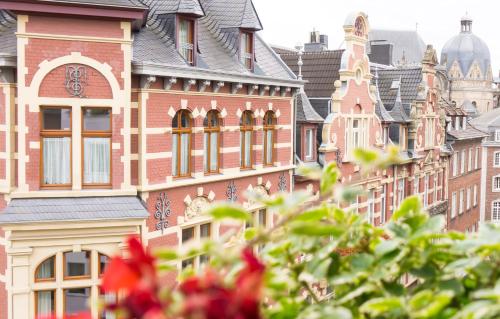It’s really not possible to rank Germany’s World Heritage Sites by their importance. Each is on the list for a different reason, and each has an engaging story behind it.
But certainly you could mount an argument that Aachen Cathedral is the most significant of them all. It was, after all, the first place in Germany to be added to the World Heritage List – and that says something about how it’s viewed here.
Aachen Cathedral was at the core of the Holy Roman Empire for centuries and, quite literally, saw kings rise and fall. It was used for coronations, for funerals. It was the private chapel for some of the greatest leaders Europe ever saw, and it was decorated accordingly.
In the structure of the church, you find different styles of architecture, reflecting the different stages of its development over more than 1200 years. While it’s one of the oldest cathedrals in Europe, it’s not even close to being one of the biggest. But in its compact form, it holds more treasures than you could ever imagine.
It’s why visiting Aachen Cathedral is well worth your time – either as a day trip detour or for an overnight stay in this charming German city.
The history of Aachen Cathedral
Aachen Cathedral was built by Charlemagne – one of Europe’s greatest rulers who united most of western and central Europe and was declared the first emperor of the Holy Roman Empire.
Construction of Aachen Cathedral began in 796AD and was inspired by the churches in the eastern part of the empire, using the Byzantine style, with churches in Ravenna and Istanbul as models.
When you go inside, you’ll still be able to see this influence yourself. The octagonal core with an emphasis on height, rather than length, reminds me more of churches I’ve seen in Greece or Serbia than France or Italy.
Charlemagne made Aachen his imperial capital and for almost 600 years, from 936 to 1531, Aachen Cathedral was used as the church of coronation. 30 German kings and 12 queens were crowned here.
It became a popular destination for pilgrims in the Middle Ages and this was one of the reasons the large choir hall was added in 1414 to the original octagonal chapel. It was designed in the Gothic style and is more voluminous than the rest of the church, about 25 metres long and 32 metres high.
In the centuries to follow, smaller chapels were added or remodelled along the sides of the church, but the basic structure didn’t change. There was significant damage in the Second World War, but nothing that wasn’t able to be repaired.
Charlemagne and the cathedral at Aachen
Although dozens of kings and queens used Aachen Cathedral over the years, and it became inherently intertwined with the story of Germany and the broader region, there is one ruler who always dominates the story of Aachen – Charlemagne.
Charlemagne may get the credit for building the foundations of Germany and France, but here in Aachen, he is most remembered for building this church.
Charlemagne constructed Aachen Cathedral as his own palace chapel. (It was originally connected to the larger Palace of Aachen – a collection of buildings from where the empire was ruled – but most of that has since been destroyed.)
He wanted it to be extravagant enough for both a man of his stature but also for the city he had chosen as his imperial capital. Some of the original fixtures from his time include bronze pieces like doors, railings, and horse statues.
When he died in 814, Charlemagne was buried in Aachen Cathedral, where he and his legacy were never forgotten.
His body was later removed from its original burial spot and put into a large shrine, built in 1215, made of an oak box covered in silver, copper, filigree and precious stones. It is now on display in the middle of the choir, one of the most prominent spots of the church.
Seeing the shrine of Charlemagne is one of the main reasons that people visit Aachen Cathedral. The decorations on the box are extremely detailed and include eight emperors sitting on thrones on each of the two longest sides.
The Aachen Cathedral Treasury
Other than the church itself and Charlemagne’s shrine, the other most important sight is the Aachen Cathedral Treasury. This is where… as the name suggests… the treasures of the church are kept – and they are simply incredible.
There are more than a hundred items in the collection and on display in the modern exhibition space. Covering the history of Aachen Cathedral, the items are from coronations, from the era of the pilgrims, from donations, and from the burial of Charlemagne.
The collection glitters, with many of the items made from gold and silver, and you’ll see chalices, reliquaries, and alterpieces. It’s not the size of the collection that’s impressive at the Aachen Cathedral Treasury (you’ll find much larger ones at other cathedrals in Europe), but the wealth of what is here.
It’s certainly worth paying the entrance fee to see the treasury when you visit.
Visiting Aachen Cathedral
Aachen Cathedral is tiny compared to other important German churches like the enormous Cologne Cathedral or Speyer Cathedral. But the small interior space means there’s an intensity to the colours and art inside.
The stained-glass windows are so finely detailed and take up so much of the walls that they dominate the light within the cathedral. But almost every other space that could be painted or covered in sculptures has been.
Every way you look there is something to admire.
It doesn’t take long to physically walk through Aachen Cathedral and you could probably almost see everything by standing in one spot and rotating.
It is worth spending the time to look at each of the different artistic styles that have been incorporated into the interior design.
If you climb up one level to where the organ is, you’ll have a fantastic view of the windows and of Charlemagne’s shrine.
Entry to Aachen Cathedral is free, but you’ll need to pay €1 to take photos inside. There is an entrance fee for the treasury, but it’s definitely worth it and I recommend you see it while you’re visiting Aachen Cathedral.
Where is Aachen Cathedral?
Aachen Cathedral is located at Domhof 1, 52062, Aachen, Germany.
You can see it on a map here.
How do you get to Aachen Cathedral?
To get to Aachen Cathedral by public transport, catch the train to Aachen and then it’s just a 15-minute walk to the site.
When is Aachen Cathedral open?
The Aachen Cathedral opening hours are as follows:
Monday to Thursday from 11:00 – 18:00
Friday and Saturday from 11:00 – 19:00
Sunday from 13:00 – 17:30
* The cathedral is closed to visitors during services
How much does it cost to visit Aachen Cathedral?
Entry to the cathedral is free although there is a voluntary donation box (plus there’s a €1 fee to take photos inside).
To visit the Aachen Cathedral Treasury, you’ll need a ticket, which is €7 for adults and €4 for concession.
Are there tours of Aachen Cathedral?
The cathedral has public tours in German every hour from 11:00 – 17:00 (Mon-Fri), 13-00 – 17:00 on Saturday, and 13:00 – 16:00 on Sundays. There is an English one at 14:00 each day.
You can also book your own group tours at €110 per group in German or an additional €25 per group in a foreign language, with a maximum of twenty people per group.
There’s a bit more information and instructions to book at the Aachen Cathedral website.
Because it’s right on the border of three countries (Germany, Belgium and the Netherlands), it’s easy to reach Aachen from other major cities – but Aachen is worth more than a day trip.
There are lots of things to see in Aachen other than the cathedral, so it’s worth considering staying overnight and exploring the city properly
THE BEST ACCOMMODATION IN AACHEN
There’s a decent mixture of business hotels and luxurious accommodations in Aachen, so you should find something for any taste.
BACKPACKER
For a good budget option, I would suggest the A&O Aachen Hauptbahnhof right at the train station.
BUDGET

For an affordable and comfortable hotel, try NiceRooms, near the city centre.
AUTHENTIC

If you’re interested in a local experience, the traditional apartments at Apartments 3 Könige Am Dom are charming.
LUXURY
And if you want to splurge, you can’t go past the majestic Parkhotel Aachen Quellenhof.
Time Travel Turtle was supported by DB Bahn, the German National Tourist Board and Youth Hostels in Germany but the opinions, over-written descriptions and bad jokes are his own.
Beautiful Cathedral… Definitely would be worth a visit. I would like to know more of the history behind it, very unique and interesting.
There’s heaps of history – much more than I could include in this story. That’s what’s so fascinating about it. You can admire it for the colours and the design, and also because of all the stories it holds within the walls.
Great post and photos to match! So beautiful
Thanks, Dan. I was worried I wasn’t capturing it it properly because it’s a really small but spectacular place. Perhaps something you need to see for yourself!
There is no denying that it is magnificent. Well done for seeing all the UNESCO Site
Thanks, Natalie. It was much more of a struggle than I thought it would be (mainly just because I got so tired without having a break for a month). But it was really worth it because they were so fascinating!
Fabulous pictures! I gotta make a trip here… I REALLY want to hear that organ!
Now, that would have been cool. Wish I could have heard a concert there. That would have been such a special experience!
Charlemagne’s Cathedral definitely does not skimp on scale or grandeur. Great shots!
I guess that someone like Charlemagne wanted a pretty impressive cathedral – and he certainly got it!! 🙂
Breathtaking! It’s amazing to see what humans can create.
Yeah, stunning. And construction started so long ago too!
I am looking for bus tour for senior citizens in Aachen herself. Would like to tour the cathedral and other sites
What a fascinating post! I loved learning about Aachen Cathedral and its rich history with Charlemagne’s shrine. The intricate architecture and the blend of Roman and Gothic styles are truly impressive. I can’t wait to visit and experience the atmosphere myself!